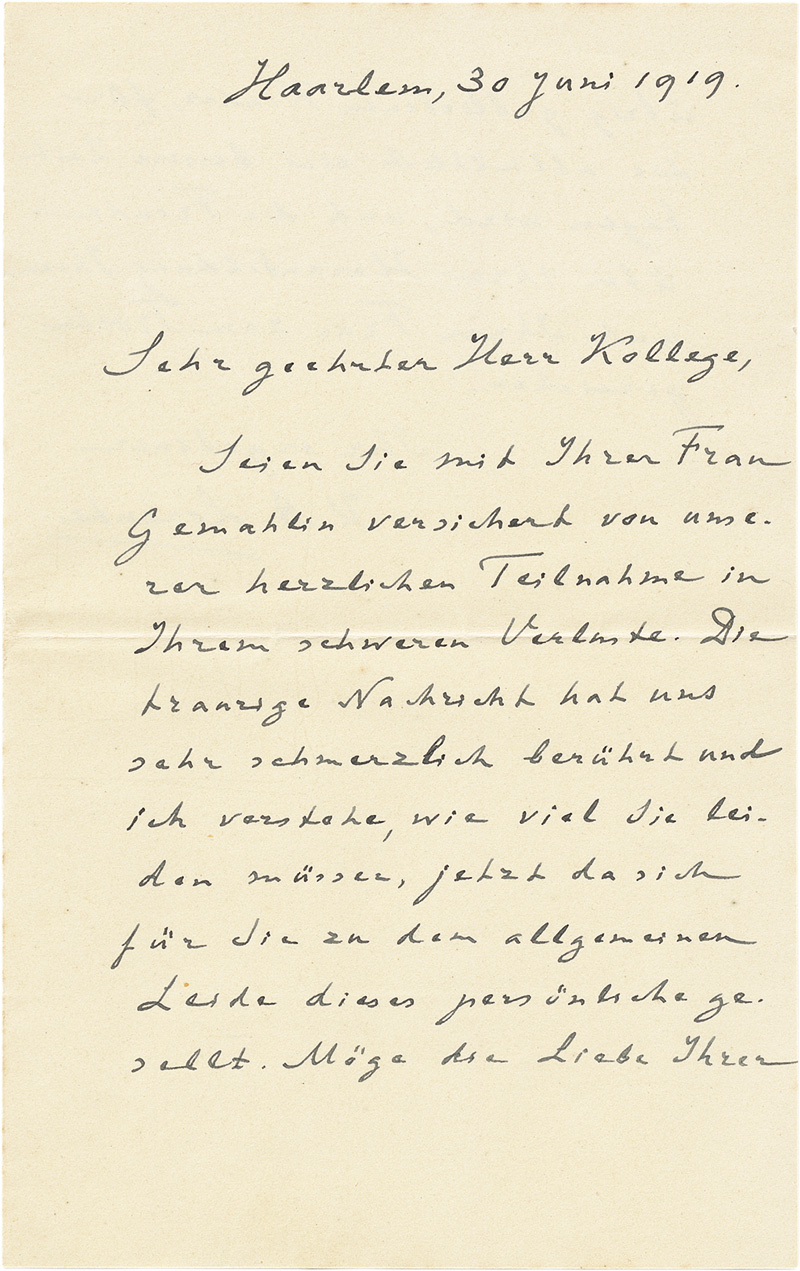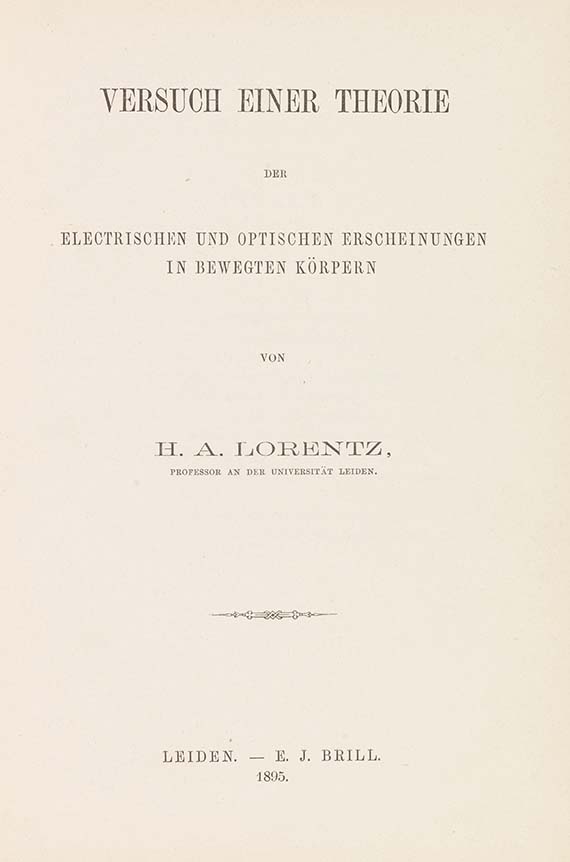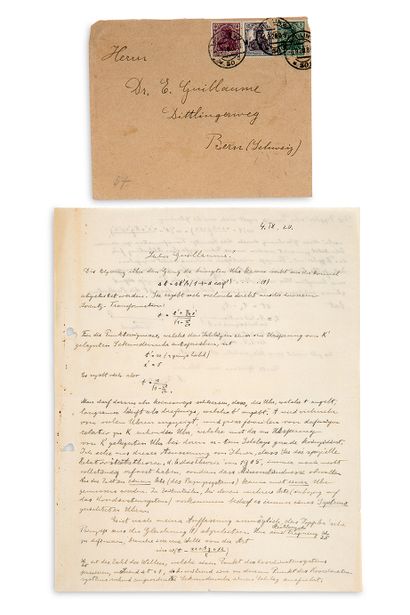Details
LORENTZ, Hendrik Antoon (1853-1928)
Large collection of scientific publications by the Dutch Nobel laureate, H.A. Lorentz, from his own private library.
This exceptional collection comprises 213 titles by Lorentz – of which over 200 are offprints – and 54 other related works; and includes works of Lorentz that laid the foundations for Einstein's theories of relativity. The highlights include:
· a luxuriously bound copy of Lorentz’s doctoral dissertation on electromagnetic optics from 1875, Over de theorie der terugkaatsing en breking van het licht (‘On the theory of reflection and refraction of light’). ‘Apart from being the first systematic treatment of electromagnetic optics, … Lorentz’s dissertation was significant as a first step toward distinguishing the electromagnetic field from matter and thus clarifying the physical basis of Maxwell’s theory’ (DSB)
· Lorentz’s inaugural lecture De moleculaire theoriën in de natuurkunde (‘The molecular theories in physics’), delivered when just 24 years-old, upon his appointment to the newly established chair in theoretical physics at the University of Leiden
· a copy of Lorentz’s second major exposition on his theory of electricity, light and matter: Versuch einer Theorie der electrischen und optischen Erscheinungen in bewegten Körpern (‘A provisional theory of electrical and optical phenomena in moving bodies’; see PMM 378b), where he for the first time formulated his theorem of corresponding states ‘to deal with problems in optics in frames of reference moving through the ether’ (DSB)
· a first edition of Einstein’s account of his theory of general relativity, Die Grundlage der allgemeinen Relativitatstheorie (PMM 408). Einstein was a close acquaintance of Lorentz and greatly admired him. Some phenomena predicted by Einstein’s theory of (special) relativity, such as the contraction of objects as they approach the speed of light, still known as the Lorentz-Fitzgerald contraction, and the notion that objects cannot be accelerated to the speed of light, had previously been predicted by Lorentz, though Einstein generalized them from charged particles to all matter and broke with the stationary ether theory that Lorentz still accepted
· extremely rare offprint by Einstein of an article on Lorentz, H.A. Lorentz et la coopération international (1928), originally published in Grotius: annuaire international. It is dated January 1928, with Einstein’s own postscript of 9 February noting Lorentz’s death (on 4 February). We have been unable to find a copy of this offprint in libraries worldwide, and the article itself is not recorded in Einstein bibliographies such as Boni, Russ & Laurence’s Bibliographical checklist. The collection also includes several curious, more practical works not mentioned in Kox’s bibliography, such as: Rapporten uitgebracht door de gecomiteerden bij de in 1883 gehouden eindexamens der gymnasia (1883; ‘Reports released by the delegates at the 1883 final examinations of the gymnasiums’), Rapport over de plaatsing en inrichting der bliksemafleiders op het rijksmuseum van schilderijen te Amsterdam (1887; ‘Report on the placement and design of lightning conductors at the Rijksmuseum of paintings in Amsterdam’), and Verslag van de commissie tot onderzoek naar de mogelijkheid eener doeltreffende-opheffing of vermindering der gehoorigheid in cellulair ingerichte gevangenissen (1897; ‘Report of the committee studying the possibility of an effective elimination or reduction of noise transmission in prisons with cells’).
Cf. Kox, ‘Bibliography of writings by Hendrik Antoon Lorentz’ in: The Scientific Correspondence of H.A. Lorentz volume 1 (2008), pp. 709-753 (a thorough bibliography, but only on a few occasions mentioning offprints); for Lorentz: DSB VIII, pp. 487-499; NDSB, pp. 333-336.
BIOGRAPHICAL BACKGROUND
Lorentz was the son of Gerrit Frederik Lorentz, a nursery owner, and Geertruida van Ginkel). His mother died when Lorentz was 4 years old, and within a few years, his father married Luberta Hupkes. Demonstrating a high academic aptitude, Lorentz entered the University of Leiden in 1870 and obtained his bachelor of science degree in mathematics and physics in less than two years. He returned to Arnhem in 1872 to become a night school teacher. During this time, he continued preparing his doctoral thesis on the reflection and refraction of light.
In 1875, aged just 22, Lorentz obtained his Ph.D, and two years later he was elected to the chair of theoretical physics at the University of Leiden. Because the field of theoretical physics was only slowly being recognised by mainstream academia, this position was the first of its kind in the Netherlands and one of the first in Europe. Lorentz remained at Leiden in this capacity for the remainder of his career.
In the 1870s, Lorentz published a paper on the relation between the velocity of light and the density and composition of the medium through which it passed. The resulting formula, proposed almost simultaneously by the Danish physicist Ludwig Lorenz, was known as the Lorenz-Lorentz formula. Lorentz based his paper on the assumption that matter contains oscillating electrically charged particles that interact with light waves. This supported the idea that matter is composed of atoms and molecules, a view not completely accepted at that time.
In the decade of the 1890s, Lorentz worked on describing electromagnetic phenomena (the propagation of light). Ever since James Bradley had reported to the Royal Society in 1729 that it was necessary to point a telescope in advance of a fixed star’s position to correctly observe it, the ‘angle of aberration’ had not been fully accounted for. Moreover, Albert Abraham Michelson had in 1881 and 1887 shown that it was impossible for any given clock to measure minute differences in relative speeds of light, as the margin of error would be greater than the differences involved. Lorentz was able to resolve these problems by assuming the electrical nature of matter (see the offprint ‘Versuch einer Theorie der electrischen und optischen Erscheinungen in bewegten Körpern’ in the current collection), and by discovering that the transition from one reference frame to another could be simplified by using a new time variable that he called ‘local time’ and which depended on universal time and the location under consideration. In 1899, and again in 1904, Lorentz added time dilation to his transformations and published what Poincaré in 1905 named Lorentz transformations. In the same year, Einstein was able, using Lorentz’s electron theory as his basis, to formulate his Special Theory of Relativity to clarify the angle of aberration. The relationship between Lorentz and Einstein is an extremely important one. It is clear that Einstein's breakthroughs were on the back of Lorentz's previous work - in fact the special theory of relativity was originally called the Lorentz–Einstein Theory; and Lorentz was one of few scientists who supported Einstein's search for general relativity from the very beginning.
In 1881, Lorentz married Alette Catharina Kaiser, daughter of J.W. Kaiser, a professor at the Academy of Fine Arts and director of what was to become the Rijksmuseum, the National Gallery of Amsterdam. The couple had two daughters and two sons. Their eldest daughter, Dr. Geertruida de Haas-Lorentz, became a physicist. Their youngest daughter Johanna Wilhelmina Lorentz married Mr dr Hendik Carel Leemhorst, Mayor of Hoorn.
DESCRIPTION
The majority octavo-sized, most of which with text in Dutch, but also many in English and German, and several in French and Italian. Many of the offprints bear a letterpress or manuscript indication that they were to be distributed by the author, e.g. ‘V.d.S.’ (‘van de schrijver’ - from the author), or ‘Überreicht von dem Verfasser’ (offered by the author), etc. Others are marked in manuscript ‘L’ indicating they are the author’s own copies.
PROVENANCE
After the death of Lorentz in 1928 and his wife Alette Catharina Kaiser in 1931, the library came into the possession of their youngest daughter Johanna Wilhelmina Lorentz and her husband Hendrik Carel Leemhorst, and thence to their son Johan Christiaan Leemhorst (1913-2000). This is the reason why the collection also contains later works such as the 9 volumes of Lorentz’s Collected papers published from 1935 until 1939, and a few works by Lorentz’s eldest daughter, the physicist Geertruida de Haas-Lorentz.
A full listing of the collection and condition reports are available from the department upon request.
Details
LORENTZ, Hendrik Antoon (1853-1928)
Large collection of scientific publications by the Dutch Nobel laureate, H.A. Lorentz, from his own private library.
This exceptional collection comprises 213 titles by Lorentz – of which over 200 are offprints – and 54 other related works; and includes works of Lorentz that laid the foundations for Einstein's theories of relativity. The highlights include:
· a luxuriously bound copy of Lorentz’s doctoral dissertation on electromagnetic optics from 1875, Over de theorie der terugkaatsing en breking van het licht (‘On the theory of reflection and refraction of light’). ‘Apart from being the first systematic treatment of electromagnetic optics, … Lorentz’s dissertation was significant as a first step toward distinguishing the electromagnetic field from matter and thus clarifying the physical basis of Maxwell’s theory’ (DSB)
· Lorentz’s inaugural lecture De moleculaire theoriën in de natuurkunde (‘The molecular theories in physics’), delivered when just 24 years-old, upon his appointment to the newly established chair in theoretical physics at the University of Leiden
· a copy of Lorentz’s second major exposition on his theory of electricity, light and matter: Versuch einer Theorie der electrischen und optischen Erscheinungen in bewegten Körpern (‘A provisional theory of electrical and optical phenomena in moving bodies’; see PMM 378b), where he for the first time formulated his theorem of corresponding states ‘to deal with problems in optics in frames of reference moving through the ether’ (DSB)
· a first edition of Einstein’s account of his theory of general relativity, Die Grundlage der allgemeinen Relativitatstheorie (PMM 408). Einstein was a close acquaintance of Lorentz and greatly admired him. Some phenomena predicted by Einstein’s theory of (special) relativity, such as the contraction of objects as they approach the speed of light, still known as the Lorentz-Fitzgerald contraction, and the notion that objects cannot be accelerated to the speed of light, had previously been predicted by Lorentz, though Einstein generalized them from charged particles to all matter and broke with the stationary ether theory that Lorentz still accepted
· extremely rare offprint by Einstein of an article on Lorentz, H.A. Lorentz et la coopération international (1928), originally published in Grotius: annuaire international. It is dated January 1928, with Einstein’s own postscript of 9 February noting Lorentz’s death (on 4 February). We have been unable to find a copy of this offprint in libraries worldwide, and the article itself is not recorded in Einstein bibliographies such as Boni, Russ & Laurence’s Bibliographical checklist. The collection also includes several curious, more practical works not mentioned in Kox’s bibliography, such as: Rapporten uitgebracht door de gecomiteerden bij de in 1883 gehouden eindexamens der gymnasia (1883; ‘Reports released by the delegates at the 1883 final examinations of the gymnasiums’), Rapport over de plaatsing en inrichting der bliksemafleiders op het rijksmuseum van schilderijen te Amsterdam (1887; ‘Report on the placement and design of lightning conductors at the Rijksmuseum of paintings in Amsterdam’), and Verslag van de commissie tot onderzoek naar de mogelijkheid eener doeltreffende-opheffing of vermindering der gehoorigheid in cellulair ingerichte gevangenissen (1897; ‘Report of the committee studying the possibility of an effective elimination or reduction of noise transmission in prisons with cells’).
Cf. Kox, ‘Bibliography of writings by Hendrik Antoon Lorentz’ in: The Scientific Correspondence of H.A. Lorentz volume 1 (2008), pp. 709-753 (a thorough bibliography, but only on a few occasions mentioning offprints); for Lorentz: DSB VIII, pp. 487-499; NDSB, pp. 333-336.
BIOGRAPHICAL BACKGROUND
Lorentz was the son of Gerrit Frederik Lorentz, a nursery owner, and Geertruida van Ginkel). His mother died when Lorentz was 4 years old, and within a few years, his father married Luberta Hupkes. Demonstrating a high academic aptitude, Lorentz entered the University of Leiden in 1870 and obtained his bachelor of science degree in mathematics and physics in less than two years. He returned to Arnhem in 1872 to become a night school teacher. During this time, he continued preparing his doctoral thesis on the reflection and refraction of light.
In 1875, aged just 22, Lorentz obtained his Ph.D, and two years later he was elected to the chair of theoretical physics at the University of Leiden. Because the field of theoretical physics was only slowly being recognised by mainstream academia, this position was the first of its kind in the Netherlands and one of the first in Europe. Lorentz remained at Leiden in this capacity for the remainder of his career.
In the 1870s, Lorentz published a paper on the relation between the velocity of light and the density and composition of the medium through which it passed. The resulting formula, proposed almost simultaneously by the Danish physicist Ludwig Lorenz, was known as the Lorenz-Lorentz formula. Lorentz based his paper on the assumption that matter contains oscillating electrically charged particles that interact with light waves. This supported the idea that matter is composed of atoms and molecules, a view not completely accepted at that time.
In the decade of the 1890s, Lorentz worked on describing electromagnetic phenomena (the propagation of light). Ever since James Bradley had reported to the Royal Society in 1729 that it was necessary to point a telescope in advance of a fixed star’s position to correctly observe it, the ‘angle of aberration’ had not been fully accounted for. Moreover, Albert Abraham Michelson had in 1881 and 1887 shown that it was impossible for any given clock to measure minute differences in relative speeds of light, as the margin of error would be greater than the differences involved. Lorentz was able to resolve these problems by assuming the electrical nature of matter (see the offprint ‘Versuch einer Theorie der electrischen und optischen Erscheinungen in bewegten Körpern’ in the current collection), and by discovering that the transition from one reference frame to another could be simplified by using a new time variable that he called ‘local time’ and which depended on universal time and the location under consideration. In 1899, and again in 1904, Lorentz added time dilation to his transformations and published what Poincaré in 1905 named Lorentz transformations. In the same year, Einstein was able, using Lorentz’s electron theory as his basis, to formulate his Special Theory of Relativity to clarify the angle of aberration. The relationship between Lorentz and Einstein is an extremely important one. It is clear that Einstein's breakthroughs were on the back of Lorentz's previous work - in fact the special theory of relativity was originally called the Lorentz–Einstein Theory; and Lorentz was one of few scientists who supported Einstein's search for general relativity from the very beginning.
In 1881, Lorentz married Alette Catharina Kaiser, daughter of J.W. Kaiser, a professor at the Academy of Fine Arts and director of what was to become the Rijksmuseum, the National Gallery of Amsterdam. The couple had two daughters and two sons. Their eldest daughter, Dr. Geertruida de Haas-Lorentz, became a physicist. Their youngest daughter Johanna Wilhelmina Lorentz married Mr dr Hendik Carel Leemhorst, Mayor of Hoorn.
DESCRIPTION
The majority octavo-sized, most of which with text in Dutch, but also many in English and German, and several in French and Italian. Many of the offprints bear a letterpress or manuscript indication that they were to be distributed by the author, e.g. ‘V.d.S.’ (‘van de schrijver’ - from the author), or ‘Überreicht von dem Verfasser’ (offered by the author), etc. Others are marked in manuscript ‘L’ indicating they are the author’s own copies.
PROVENANCE
After the death of Lorentz in 1928 and his wife Alette Catharina Kaiser in 1931, the library came into the possession of their youngest daughter Johanna Wilhelmina Lorentz and her husband Hendrik Carel Leemhorst, and thence to their son Johan Christiaan Leemhorst (1913-2000). This is the reason why the collection also contains later works such as the 9 volumes of Lorentz’s Collected papers published from 1935 until 1939, and a few works by Lorentz’s eldest daughter, the physicist Geertruida de Haas-Lorentz.
A full listing of the collection and condition reports are available from the department upon request.


.jpg)







.jpg)



Try LotSearch and its premium features for 7 days - without any costs!
Be notified automatically about new items in upcoming auctions.
Create an alert